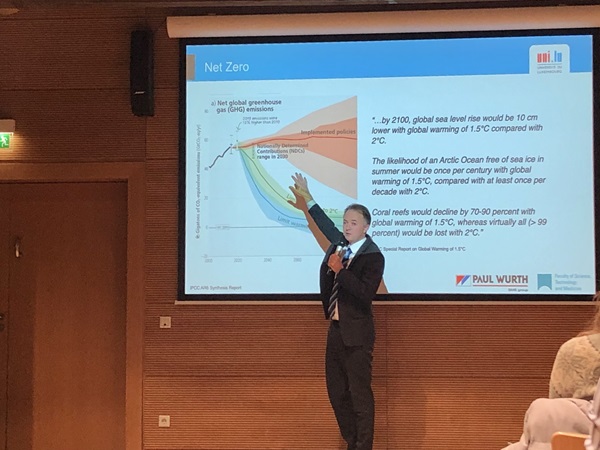 Credit: Otilia Dragan/Chronicle.lu
Credit: Otilia Dragan/Chronicle.lu
On the evening of Thursday 30 November 2023, Professor Bradley Ladewig, full professor of Engineering at the Faculty of Science, Technology and Medicine at the University of Luxembourg held a lecture about hydrogen as a potential solution for the energy transition.
Entitled “Is Hydrogen really the energy of the future?”, the presentation delved into details about the key role hydrogen will play in the transformation towards Net Zero. Before defining and explaining the uses of hydrogen and its promise for the future, Professor Bradley Ladewig discussed the realities of climate change.
He gave the example of driving a car 50% faster than it was ever designed to drive, and continuously accelerating. He described the current ways people inhabit the earth as an “experiment” for which there are no known end results. The difference, however, is that this experiment does not involve a controlled lab trial but instead the equivalent of a dangerous accelerating drive with one’s children in the backseat.
This year has seen a number of records, both temperature-wise and in terms of ecological catastrophes – in April catastrophic flooding in Yemen caused tens of thousands of deaths. While our goal is to reach net zero, which involves cutting gas emissions to as close to zero as possible, CO2 emissions have been increasing since they briefly took a dip during the COVID pandemic. The goal is to limit global warming to 1.5℃ maximum, or 2℃ if the latter is not possible. While this may not seem like a lot, Professor Bradley Ladewig stressed that if the world heats up by an additional 2℃, sea levels rising will make certain islands and parts of the world uninhabitable. With a 1.5℃ warming, 90% of coral reefs will die while 2℃ would mean they would all die.
“We need a massive, significant reduction of CO2,” he stressed, and added that the main interest in hydrogen is its promise concerning decarbonisation.
Hydrogen is the lightest element and the most abundant in the universe. For every 18 grams water, there are 2 grams of hydrogen. Several hydrogen types exist, divided by “colour”: grey, blue and green (among others). Grey hydrogen is already being used today, and it is derived from methane. Blue hydrogen is like grey hydrogen with the difference that the CO2 emitted is captured and stored (underground). Green hydrogen is made by splitting water and is also known as a “renewable fuel of non-biological origin” at the European legislative level.
Green hydrogen can be obtained through electrolysis and has a vast spectrum of applications: industrial transformation, decarbonisation, transport and heating to name a few. In practice, however, many of these uses do not “make sense” due to cheaper and faster options already available. One of these potential uses of hydrogen is fuelling cars – certain models running on hydrogen exist (Toyota Mirai; Tesla Model 3) but the scarcity of refuelling stations and the high cost makes them less suitable for private vehicles. Due to the very short time needed to refuel (three to five minutes), it would make sense for vehicles always on the road, such as taxis, to be hydrogen models.
Heavy transport (trucks) which drive over long distances cannot be taken off the road too long for charging, which is where hydrogen would be a favourable option. The difficulty there, however, is the extremely high costs incurred by the need to replace the high number of trucks currently in circulation by hydrogen-fuelled ones.
Air transport is responsible for the fastest-growing emissions, which is why hydrogen-fuelled models would be an important addition. Liquid hydrogen, however, is difficult to produce, handle and store on board of aeroplanes, which is why Professor Bradley Ladewig noted that the likelihood of the industry of commercial liquid-hydrogen-fuelled aviation is slim. Another solution for aviation would be to swap out fossil-derived kerosene with a renewable form of kerosene. This type of fuel may be around ten times more expensive, however. The reality is that we will have to fly less and pay more for our flights, the professor stressed.
One industry in which promising progress has already been made is the metal production industry. Hydrogen can be made, stored and used to reduce iron pellets into sponge iron (metallic iron) that can then be processed to form steel.
While hydrogen cannot solve all problems to stop climate change, it will likely play a key role in industry. Professor Bradley Ladewig finished the lecture by emphasising the importance of making significant changes to drive CO2 down.








